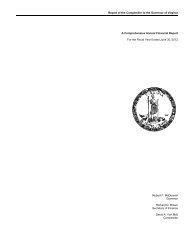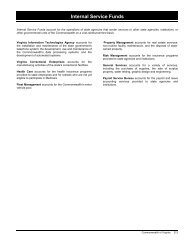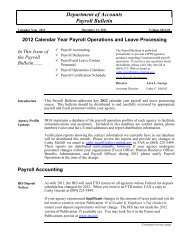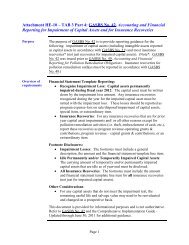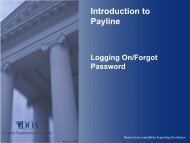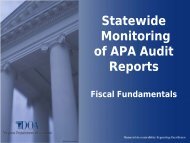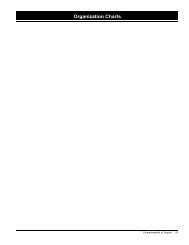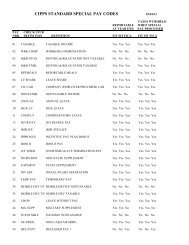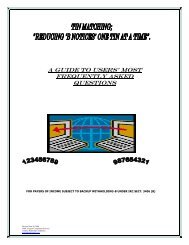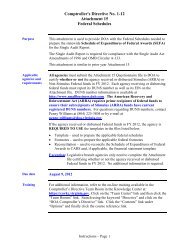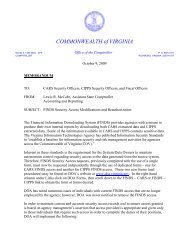Attachment 5 - Virginia Department of Accounts
Attachment 5 - Virginia Department of Accounts
Attachment 5 - Virginia Department of Accounts
- No tags were found...
You also want an ePaper? Increase the reach of your titles
YUMPU automatically turns print PDFs into web optimized ePapers that Google loves.
Comptroller’s Directive No. 3-07<strong>Attachment</strong> 5Leave Liability Statement – CIPPS and Non-CIPPS UsersPurposeThis attachment is used to accumulate leave liability information forrecording compensated absence liabilities in accordance with GAAP. Thisattachment is similar to prior year’s <strong>Attachment</strong> 5.ApplicableagenciesAll agencies and funds with compensated absence liabilities (whether CIPPSis used or not) that are not included on a financial statement template mustcomplete this attachment.Note: The Payroll Service Bureau will complete Part 1 <strong>of</strong> the attachmentrelated to CIPPS users for all agencies using the Bureau’s services and willforward the attachment to the agency for review and approval. These agenciesmust still complete Questions A through E on the CIPPS-Part 1 tab andsubmit the attachment to DOA using the submission requirements below.Note: Since the Library <strong>of</strong> <strong>Virginia</strong>, the <strong>Department</strong> <strong>of</strong> Corrections, and the<strong>Department</strong> <strong>of</strong> Mental Health, Mental Retardation, and Substance AbuseServices use CIPPS for some employees, DOA will provide the U007 andU008 reports to assist in the preparation <strong>of</strong> Part 3 <strong>of</strong> the Non-CIPPS tab, ifrequested. Contact Sharon Lawrence at (804)-225-2414 orSharon.lawrence@doa.virginia.gov to receive these reports.Due date August 2, 2007CertificationThe Certification tab is new for FY 2007, and it requires all preparers andreviewers to type their name on this form. Please note that there should be asegregation <strong>of</strong> duties; therefore, the preparer and the reviewer should not bethe same individual for any tab. By typing a name, the individual is certifyingthat all tabs <strong>of</strong> this attachment have been reviewed, the information is bothcomplete and accurate, and the preparer and reviewer were not the sameindividual for any tab.Continued on next pageInstructions – Page 1
SubmissionrequirementsComptroller’s Directive No. 3-07<strong>Attachment</strong> 5Leave Liability Statement – CIPPS and Non-CIPPS UsersContact DOA if the agency has any problems with the spreadsheets.After downloading the files, rename the spreadsheet file using the agencynumber followed by Att5. For example, agency 151 should rename its<strong>Attachment</strong> 5.xls file as 151Att5.xls.Submit the Excel spreadsheet electronically t<strong>of</strong>inrept-agyatt@doa.virginia.gov.Copy APA via e-mail to APAFinRept@apa.virginia.gov.Do not submit paper copies <strong>of</strong> the Excel spreadsheet.<strong>Attachment</strong>revisionsIf attachment revisions are made subsequent to DOA acknowledgement <strong>of</strong>receipt and acceptance <strong>of</strong> the original attachment submission, resubmit therevised attachment AND complete the Revision Control Log Tab in theattachment excel file.Enter the revision date, row number and column letter revised, and theprevious and revised information. Document text changes and numericalchanges. Only enter changes for amounts actually keyed. For example, if anon-keyed, calculated total changes as a result <strong>of</strong> the revision, this does notneed to be documented on the Revision Control Log.If the attachment is revised more than once, do not delete control log revisioninformation from the previous revision. Enter the new revision date and theadditional revisions in the rows following the initial revision rows. This logshould document all revisions from the initial attachment submission.Each time a revision is submitted the Certification tab should be updatedwith new signatures and dates.Continued on next pageInstructions – Page 2
Comptroller’s Directive No. 3-07<strong>Attachment</strong> 5Leave Liability Statement – CIPPS and Non-CIPPS UsersDefinitionsCurrent Leave Liability – The portion <strong>of</strong> accrued leave liability associatedwith employees who terminated on or before June 24, 2007, and who will notbe paid for compensated leave until after June 30, 2007.Long-term Leave Liability – The liability for accrued annual, sick ordisability credits, compensatory, overtime, on-call leave, and applicablesabbatical leave for all leave-eligible employees employed by the State onJune 25, 2007.• Long-term Leave Liability Due Within One Year – The portion <strong>of</strong>long-term leave liability that is due within one year after the fiscalyear end. For fiscal year 2007, it is the liability due by June 30, 2008.• Long-term Leave Liability Due Greater Than One Year – Theportion <strong>of</strong> long-term leave liability that is due after June 30, 2008.Note: Current leave liability is based on actual amounts owed and isreported on the modified accrual basis <strong>of</strong> accounting whereas long-termleave due within one year is an estimate <strong>of</strong> leave to be paid and / or usedwithin one year after fiscal year end and is reported on the full accrualbasis <strong>of</strong> accounting.For governmental funds, only the current leave liability (as defined above)should be reported in the fund statements. The long-term amount due withinone year and the long-term amount due greater than one year should bereported in the government-wide statements.Continued on next pageInstructions – Page 3
Comptroller’s Directive No. 3-07<strong>Attachment</strong> 5Leave Liability Statement – CIPPS and Non-CIPPS UsersGASBS No. 16requirementsGASBS No. 16, Accounting for Compensated Absences, requires the accrual<strong>of</strong> compensated absence liability, regardless <strong>of</strong> fund type. Leave liabilityshould include the following:• Employer’s share <strong>of</strong> Social Security and Medicare taxes on all accruedcompensated absences• Termination payments for sick leave or disability credits limited to thelesser <strong>of</strong> 25% <strong>of</strong> leave earned or $5,000• Other leave earned such as sabbatical leave (if unrestricted in nature), oncall,overtime, and compensatory leave that has not been used by or paidto the employee• Employer contribution payments made to defined contribution or costsharingmultiple employer defined benefit pension plans, if associatedwith serviceImpact <strong>of</strong><strong>Virginia</strong>Sickness andDisabilityProgram(VSDP)For those employees who participate in the VSDP and converted sick leavebalances to <strong>Virginia</strong> Retirement System service credit, the accrual forcompensated absences will no longer include an amount for sick leave.However, for those employees who participate in the VSDP and convertedsick leave balances to disability credits, the accrual for compensated absenceswill include an amount for disability credits. The calculation <strong>of</strong> thisamount should result in the same amount as would have been calculated forsick leave had these employees remained in the non-VSDP sick leaveprogram. The sick leave or disability credits liability is limited to the lesser<strong>of</strong> 25% <strong>of</strong> leave earned or $5,000.Continued on next pageInstructions – Page 4
Comptroller’s Directive No. 3-07<strong>Attachment</strong> 5Leave Liability Statement – CIPPS and Non-CIPPS UsersFunctionalcodes definedFunctional codes are the first number in every service area. For example,service area 1031000 “Community Services” would fall under the“Education” function. Each functional code and its corresponding descriptionare below.1-Education3-Administration <strong>of</strong> Justice4-Individual and Family Services5-Resources and Economic Development6-Transportation7-General Government8-EnterpriseSocial Securityand MedicaretaxesThe CIPPS reports have been modified to include the Social Security (6.2%on a maximum salary base <strong>of</strong> $97,500) and Medicare taxes (1.45%, no salarylimit) on the accrued leave.GeneralInformationand Summary<strong>of</strong> <strong>Attachment</strong>Information should only be entered in yellow cells. Validation fields havebeen created to ensure agreement between appropriate amounts reported oneach page. If error messages are displayed, please revise the information asrequired to eliminate the error messages.The leave attachment is comprised <strong>of</strong> the following:• Contact Information• Questions A-E• Part 1 – Leave Liability on CIPPS• Part 2 – Leave Liability NOT on CIPPS• Part 3 – Non-CIPPS Leave Liability Due within One Year and DueGreater than One Year (Pages 9 and 10 provide an auditor approvedmethodology that can be used to complete Part 3)• Part 4 – Non-CIPPS GASBS No. 34 Footnote Disclosure• Part 5 – Variance Analysis• Certification TabContinued on next pageInstructions – Page 5
Comptroller’s Directive No. 3-07<strong>Attachment</strong> 5Leave Liability Statement – CIPPS and Non-CIPPS UsersCompletingPart 1- LeaveLiability onCIPPSDOA has extracted leave data from the CIPPS file. This data is provided inthe Leave Liability Database file posted on DOA’s website atwww.doa.virginia.gov. Click on the “Financial Reporting” link, then clickon “Financial Statement Directives.” Note: The file will not be availableon the website until mid-July 2007.The Leave Liability Database file has been modified to combine variousreporting funds (i.e., 0100 and 1100, 0200 and 2200). In addition, if anyleave liability amounts were coded to capital outlay (functional code 9) theseamounts have been combined with the most predominant expenditurefunctional code used by the agency.Determine whether any adjustments are required to correct the total shown onthe Leave Liability Database. Consider the following items to determinewhether the amounts are accurate:• Did the agency receive leave slips for absences on or before June 24,2007, that were not processed in CIPPS? The following exceptions donot require adjustments:• Leave slips for absences during June 25, 2007, through June 30, 2007• Late leave slips for leave taken prior to June 25, 2007• Will the agency have payouts to terminated employees paid after June 24,2007, but prior to July 1, 2007?• Does the agency have additional leave liability for sabbatical leave ornon-VRS pension contributions not accounted for on CIPPS?1. Make the necessary adjustments based on the questions above and enterthe totals in Part 1 (Steps 1 through 4).2. Determine if any <strong>of</strong> the total entered in Step 4 represents current leaveliability (leave liability amount for employees terminated on or beforeJune 24, 2007, but will not be paid for the leave until after June 30, 2007).Enter any current leave liability in Step 5. The long-term leave liabilitywill be automatically calculated in Step 6.Note: Do not confuse current leave liability with leave liability due withinone year. DOA will calculate the leave liability due within one year for allleave amounts on CIPPS.Continued on next pageInstructions – Page 7
Comptroller’s Directive No. 3-07<strong>Attachment</strong> 5Leave Liability Statement – CIPPS and Non-CIPPS UsersCompletingPart 2 – LeaveLiability NOTon CIPPSPerform the following steps to calculate leave liability for employees that arenot on CIPPS:1. Determine the leave balance at June 24 for each employee, using theagency’s records. Leave should include annual, compensatory, overtime,on-call, 25% <strong>of</strong> sick or disability credits, and applicable sabbaticalleave.2. Determine each employee’s hourly rate by dividing the annual salary atJune 24 by standard full time hours <strong>of</strong> 2,080.3. Multiply the hours for each leave category by the hourly rate. (Seespecial instructions on Page 3 for sick leave or disability credits.)4. Calculate and include employer’s tax payment for Social Security andMedicare on the leave liability. Based on individual employee salaries,Social Security is 6.2% on a maximum salary base <strong>of</strong> $97,500 andMedicare is 1.45% on all salaries.5. Compute additional leave liability for sabbatical leave and any pensioncontributions if applicable. (Since VRS is an agent multiple-employerdefined benefit plan, no additional accrual is necessary for VRScontributions.)6. Allocate the leave liability for each employee to the appropriate fundsbased on the total salary provided by each fund / fund detail and function.(Functions are described on Instructions – Page 5 <strong>of</strong> this attachment.)7. Aggregate the information at the agency level.8. Enter the totals by Agency, Fund Detail, and Function in Part 2 (Steps 1through 4).9. Determine if any <strong>of</strong> the total entered in Step 4 represents current leaveliability (leave liability amount for employees terminated on or beforeJune 24, 2007, but will not be paid for the leave until after June 30, 2007).Enter any current leave liability in Step 5. The long-term leave liabilitywill be automatically calculated in Step 6.10. Retain copies <strong>of</strong> all computations for review by auditors.Note: Do not confuse current leave liability with leave liability due withinone year. The agency must calculate leave due within one year in Part 3 foramounts NOT on CIPPS.Continued on next pageInstructions – Page 8
Comptroller’s Directive No. 3-07<strong>Attachment</strong> 5Leave Liability Statement – CIPPS and Non-CIPPS UsersCompletingPart 3 –ManuallyCalculate theNon-CIPPSAmount Duewithin one yearThe total leave liability NOT on CIPPS was already entered in Part 2 (Step 4).GASBS No. 34 requires that this amount be reported on the GovernmentwideStatements in two line items - amount due within one year and amountdue in greater than one year. Agencies have to manually calculate the portionthat is due within one year.Leave liability becomes due upon the occurrence <strong>of</strong> relevant events such asresignations, retirements, and uses <strong>of</strong> leave balances. These events cannot beknown reliably in advance so the amount due within one year must beestimated.The following is an auditor approved suggested methodology. Uponcalculating the long-term leave liability due within one year and greaterthan one year, report the amounts in Part 3.Perform the following steps to calculate the amount due within one year.1. Project the number <strong>of</strong> annual and sick leave hours that will be accrued inthe next fiscal year (July 1, 2007, to June 30, 2008) for each employeeand in total. (Maximum carry forward limits should not have to be takeninto account as the amount accrued in a 12 month period cannot exceedthe maximum limits by years <strong>of</strong> service.)2. Determine each employee’s hourly rate by dividing the salary rate at June24, 2007 by standard full time hours <strong>of</strong> 2,080.3. Multiply the projected hours in Step 1 for each leave category by thehourly rate.Continued on next pageInstructions – Page 9
Comptroller’s Directive No. 3-07<strong>Attachment</strong> 5Leave Liability Statement – CIPPS and Non-CIPPS UsersCompleting Part 3 – Manually Calculate the Non-CIPPS Amount Due within one year (continued)4. Calculate a percentage for annual leave hours used and paid out comparedto annual leave hours accrued. Calculate a second percentage for sickleave hours used and paid out compared to sick leave hours accrued. (Forexample, agency XYZ used and / or paid out 1,000 hours <strong>of</strong> annual leave.The annual leave hours earned for agency XYZ were 4,000. Therefore,the percentage factor for XYZ annual leave usage would be 25%). Thiscalculation can be done on a fiscal year or calendar year basis usinghistorical data.5. Multiply the percentages for annual and sick leave usage in Step 4 by theprojected annual and sick leave liabilities calculated in Step 3.6. Aggregate the information for annual and sick leave in total. This is theamount due within one year.7. Adjust the long-term leave liability for the amount due within one year.8. Retain copies <strong>of</strong> all computations for review by auditors.CompletingPart 4 – Non-CIPPS GASBSNo. 34 footnotedisclosureThe following information is required footnote disclosure under GASBS No.34.• Beginning Balance – should equal the prior year ending balance.• Increases – use the projected amount calculated in Step 3 from FY 2006or actual current year information.• Decreases – calculated amount since other three amounts are known• Ending Balance – should equal the total leave liability calculated.DOA realizes the projected leave liability amounts are being used as currentyear increases. (Agencies may calculate increases based on actual currentyear information.) The due within one year amount calculated for thecurrent fiscal year can be used as increases in the next fiscal year.CompletingPart 5 –VarianceAnalysisThe total leave liability amounts entered in Parts 1 and 2 are summed inPart 5. This amount is compared to the prior year ending balance which wasentered automatically when the agency number was selected.Provide an explanation in the yellow box if the variance between current andprior years balance is greater than 10% and $1,500,000.Instructions – Page 10




